Configuration Strategy and Performance Analysis of Combined Heat and Power System Integrated with Biomass Gasification, Solid Oxide Fuel Cell, and Steam Power System
Abstract
:1. Introduction
| Study | Input Energy | System Configuration | Strategy | No. of Structures | Variable Heat-To-Power Ratio |
|---|---|---|---|---|---|
| Pan et al. (2019) [21] | Natural gas–solar energy–grid | Gas turbine–photovoltaics–gas boiler–battery–absorption chiller | Optimization-based | 1 | Yes |
| Liu et al. (2020) [22] | Solar energy–natural gas | Photovoltaics–SOFC–gas turbine–gas boiler | Optimization-based | 2 | Yes |
| Alabi et al. (2020) [23] | Solar energy–wind–grid | Photovoltaics–wind turbine–PEMFC | Optimization-based | 1 | Yes |
| Yang et al. (2021) [24] | Wind–natural gas–grid | Wind turbine–gas turbine–absorption chiller | Optimization-based | 1 | Yes |
| Liu et al. (2023) [25] | Solar energy–wind–natural gas–grid | Photovoltaics–wind turbine–gas turbine | Optimization-based | 1 | Yes |
| Mei et al. (2021) [26] | Natural gas | SOFC–thermoelectric generator–absorption heat pomp | Dispatching components | 4 | Yes |
| Fu et al. (2024) [19] | Biomass | Biomass gasification–SOFC–gas turbine–absorption refrigerating–organic Rankine cycle | Dispatching components | 7 | Yes |
| Li et al. (2023) [8] | Biomass–solar energy–grid | Solar driven biomass gasification–gas turbine | — | 1 | No |
| This study | Biomass–solar energy–grid | Solar driven biomass gasification–SOFC–gas turbine–steam power system | Dispatching components | 3 | Yes |
- (1)
- A CHP system integrating solar-driven biomass gasification, SOFC-GT, and SPS is proposed based on the cascade utilization principle of renewable energy, efficiently promoting the utilization of renewable energy.
- (2)
- To enhance the flexibility of the system, a configuration strategy is proposed that allows us to adjust the system’s output by manipulating the valve opening. This approach enables precise control over the system’s operation and allows for dynamic adjustments based on the changing energy demand, thereby optimizing the system performance and ensuring efficient energy utilization.
- (3)
- The system simulation model is established using Aspen Plus V11, a chemical process simulation software. In this simulation model, a variable efficiency model is employed for the turbine. Unlike the constant efficiency model [27,28], the influence of load variation on equipment efficiency is considered.
- (4)
- The impact of the gasification temperature, steam-to-biomass ratio, and fuel cell temperature on the performance of the system is examined. Energy and economic evaluations under different configurations are performed for systems with different configurations, then the systems’ energy production and adjustable range are given.
2. System Description
2.1. Solar-Driven Biomass Gasification (SBG)
2.2. Solid Oxide Fuel Cell and Gas Turbine (SOFC-GT)
2.3. Steam Power System (SPS)
2.4. Throttle Valve
3. Modeling and Evaluation Criteria
3.1. Model Assumptions
- Biomass gasification is assumed to be complete.
- Both the gasification reaction and the reforming reaction in the SOFC are assumed to be steady-state processes.
- H, O, N, and S in biomass are converted into gaseous products.
- CO is transformed to H2 by the reforming reaction, without taking into account the electrochemical reaction of CO.
- The mass fraction of N2 and O2 in the air is assumed to be 79% and 21%, respectively.
- All gases are assumed to be ideal.
- All steam is assumed to be saturated steam.
3.2. System Modeling
3.2.1. SBG Modeling
3.2.2. Syngas Cleaning Modeling
3.2.3. SOFC-GT Modeling
3.2.4. SPS Modeling
3.3. Energy Performance
3.4. Economic Performance
4. Results and Discussion
4.1. Model Validation
4.2. Key Parametric Analysis
4.2.1. Effect of Gasification Parameters on SOFC Output Power
4.2.2. Effect of SOFC Operating Temperature
4.3. Scope of System Regulation
4.3.1. Energy Analysis
4.3.2. Economic Analysis
4.3.3. Simulation Results of SPS
5. Conclusions
- (1)
- By studying the influence of system operating parameters, it is observed that the output power of the SOFC can be enhanced by maintaining a low S/B ratio and a high gasification temperature. Specifically, the maximum SOFC power is reached at a gasification temperature of 950 °C and an S/B of 0.2. Additionally, increasing the operating temperature of the SOFC contributes to an increase in its voltage and output power, but after 950 °C, this growth trend slows down.
- (2)
- Within a specified range of operating conditions, the system exhibits an adjustable output power range of 11.52 MW to 365.21 MW. The energy efficiency reaches its peak at 66.05% when rv1 is set to 0.4, indicating that the hybrid system has more advantages in terms of energy efficiency than the single system. The heat-to-power ratio of the system can be adjusted within the range of 0.89 to 28.09 in order to effectively meet varying energy demand.
- (3)
- Our economic analysis reveals that the system is economically feasible as the NPV is greater than zero, and the LCOE is USD 0.16/kWh. The interest rate and system lifespan have an impact on the economy index. Specifically, increasing the interest rate and decreasing the system lifespan lead to a decrease in the NPV.
Supplementary Materials
Author Contributions
Funding
Data Availability Statement
Conflicts of Interest
References
- Saboori, H.; Mehrjerdi, H. Techno-economic-environmental modeling, joint optimization, and sensitivity analysis of a combined water desalination-hybrid renewable supply system. Int. J. Energy Res. 2022, 46, 12323–12340. [Google Scholar] [CrossRef]
- Piña-Martinez, A.; Lasala, S.; Privat, R.; Falk, V.; Jaubert, J.-N. Design of Promising Working Fluids for Emergent Combined Cooling, Heating, and Power (CCHP) Systems. ACS Sustain. Chem. Eng. 2021, 9, 11807–11824. [Google Scholar] [CrossRef]
- Zhao, P.; Gou, F.; Xu, W.; Shi, H.; Wang, J. Energy, exergy, economic and environmental (4E) analyses of an integrated system based on CH-CAES and electrical boiler for wind power penetration and CHP unit heat-power decoupling in wind enrichment region. Energy 2023, 263, 125917. [Google Scholar] [CrossRef]
- Yun, H.; Dai, J.; Tan, T.; Bi, X. Accelerate Large-Scale Biomass Residue Utilization via Cofiring to Help China Achieve Its 2030 Carbon-Peaking Goals. Env. Sci Technol 2023, 57, 9163–9173. [Google Scholar] [CrossRef]
- Yan, P.; Xiao, C.; Xu, L.; Yu, G.; Li, A.; Piao, S.; He, N. Biomass energy in China’s terrestrial ecosystems: Insights into the nation’s sustainable energy supply. Renew. Sustain. Energy Rev. 2020, 127, 109857. [Google Scholar] [CrossRef]
- NDRC; Development and Reform Commission of the Peoples Republic of China. 14th Five-Year Plan for Renewable Energy Development (2021–2025); NDRC: Beijing, China, 2021.
- Yu, D.; Hu, J.; Wang, W.; Gu, B. Comprehensive techno-economic investigation of biomass gasification and nanomaterial based SOFC/SOEC hydrogen production system. Fuel 2023, 333, 126442. [Google Scholar] [CrossRef]
- Li, Z.; Zhu, X.; Huang, X.; Tian, Y.; Huang, B. Sustainability design and analysis of a regional energy supply CHP system by integrating biomass and solar energy. Sustain. Prod. Consum. 2023, 41, 228–241. [Google Scholar] [CrossRef]
- Xu, D.; Gu, X.; Dai, Y. Concentrating solar assisted biomass-to-fuel conversion through gasification: A review. Front. Energy Res. 2023, 10, 1029477. [Google Scholar] [CrossRef]
- IRENA. Renewable Power Generation Costs in 2021; International Renewable Energy Agency: Abu Dhabi, United Arab Emirates, 2022. [Google Scholar]
- Wu, H.; Liu, Q.; Bai, Z.; Xie, G.; Zheng, J.; Su, B. Thermodynamics analysis of a novel steam/air biomass gasification combined cooling, heating and power system with solar energy. Appl. Therm. Eng. 2020, 164, 114494. [Google Scholar] [CrossRef]
- He, Y.; Guo, S.; Dong, P.; Lv, D.; Zhou, J. Feasibility analysis of decarbonizing coal-fired power plants with 100% renewable energy and flexible green hydrogen production. Energy Convers. Manag. 2023, 290, 117232. [Google Scholar] [CrossRef]
- Ahmed, K.; Föger, K. Analysis of equilibrium and kinetic models of internal reforming on solid oxide fuel cell anodes: Effect on voltage, current and temperature distribution. J. Power Sources 2017, 343, 83–93. [Google Scholar] [CrossRef]
- Choudhury, A.; Chandra, H.; Arora, A. Application of solid oxide fuel cell technology for power generation—A review. Renew. Sustain. Energy Rev. 2013, 20, 430–442. [Google Scholar] [CrossRef]
- Shayan, E.; Zare, V.; Mirzaee, I. On the use of different gasification agents in a biomass fueled SOFC by integrated gasifier: A comparative exergo-economic evaluation and optimization. Energy 2019, 171, 1126–1138. [Google Scholar] [CrossRef]
- Wang, J.; Al-attab, K.A.; Yew Heng, T. Techno-economic and thermodynamic analysis of solid oxide fuel cell combined heat and power integrated with biomass gasification and solar assisted carbon capture and energy utilization system. Energy Convers. Manag. 2023, 111, 280. [Google Scholar] [CrossRef]
- Timurkutluk, B.; Timurkutluk, C.; Mat, M.D.; Kaplan, Y. A review on cell/stack designs for high performance solid oxide fuel cells. Renew. Sustain. Energy Rev. 2016, 56, 1101–1121. [Google Scholar] [CrossRef]
- Kumar, P.; Singh, O. Thermoeconomic analysis of SOFC-GT-VARS-ORC combined power and cooling system. Int. J. Hydrogen Energy 2019, 44, 27575–27586. [Google Scholar] [CrossRef]
- Fu, C.; Wang, J.; Shen, Q.; Cui, Z.; Ding, S. Determining the optimal biomass-gasification-based fuel cell trigeneration system in exergy-based cost and carbon footprint method considering energy level. Energy Convers. Manag. 2024, 299, 117802. [Google Scholar] [CrossRef]
- Li, B.; Roche, R.; Paire, D.; Miraoui, A. Sizing of a stand-alone microgrid considering electric power, cooling/heating, hydrogen loads and hydrogen storage degradation. Appl. Energy 2017, 205, 1244–1259. [Google Scholar] [CrossRef]
- Pan, G.; Gu, W.; Wu, Z.; Lu, Y.; Lu, S. Optimal design and operation of multi-energy system with load aggregator considering nodal energy prices. Appl. Energy 2019, 239, 280–295. [Google Scholar] [CrossRef]
- Liu, Z.; Zhao, Y.; Wang, X. Long-term economic planning of combined cooling heating and power systems considering energy storage and demand response. Appl. Energy 2020, 279, 115819. [Google Scholar] [CrossRef]
- Alabi, T.M.; Lu, L.; Yang, Z.; Zhou, Y. A novel optimal configuration model for a zero-carbon multi-energy system (ZC-MES) integrated with financial constraints. Sustain. Energy Grids Netw. 2020, 23, 100381. [Google Scholar] [CrossRef]
- Yang, X.; Chen, Z.; Huang, X.; Li, R.; Xu, S.; Yang, C. Robust capacity optimization methods for integrated energy systems considering demand response and thermal comfort. Energy 2021, 221, 119727. [Google Scholar] [CrossRef]
- Liu, J.; Li, Y.; Ma, Y.; Qin, R.; Meng, X.; Wu, J. Two-layer multiple scenario optimization framework for integrated energy system based on optimal energy contribution ratio strategy. Energy 2023, 285, 128673. [Google Scholar] [CrossRef]
- Mei, S.; Lu, X.; Zhu, Y.; Wang, S. Thermodynamic assessment of a system configuration strategy for a cogeneration system combining SOFC, thermoelectric generator, and absorption heat pump. Appl. Energy 2021, 302, 117573. [Google Scholar] [CrossRef]
- Fan, S.; Li, Z.; Wang, J.; Piao, L.; Ai, Q. Cooperative Economic Scheduling for Multiple Energy Hubs: A Bargaining Game Theoretic Perspective. IEEE Access 2018, 6, 27777–27789. [Google Scholar] [CrossRef]
- Wang, A.; Liu, J.; Wang, W. Flexibility-based improved model of multi-energy hubs using linear weighted sum algorithm. J. Renew. Sustain. Energy 2018, 10, 015901. [Google Scholar] [CrossRef]
- Yari, M.; Mehr, A.S.; Mahmoudi, S.M.S.; Santarelli, M. A comparative study of two SOFC based cogeneration systems fed by municipal solid waste by means of either the gasifier or digester. Energy 2016, 114, 586–602. [Google Scholar] [CrossRef]
- Bocci, E.; Di Carlo, A.; McPhail, S.J.; Gallucci, K.; Foscolo, P.U.; Moneti, M.; Villarini, M.; Carlini, M. Biomass to fuel cells state of the art: A review of the most innovative technology solutions. Int. J. Hydrogen Energy 2014, 39, 21876–21895. [Google Scholar] [CrossRef]
- Ud Din, Z.; Zainal, Z.A. Biomass integrated gasification–SOFC systems: Technology overview. Renew. Sustain. Energy Rev. 2016, 53, 1356–1376. [Google Scholar] [CrossRef]
- AlNouss, A.; McKay, G.; Al-Ansari, T. Production of syngas via gasification using optimum blends of biomass. J. Clean. Prod. 2020, 242, 118499. [Google Scholar] [CrossRef]
- Singh, D.K.; Tirkey, J.V. Modeling and multi-objective optimization of variable air gasification performance parameters using Syzygium cumini biomass by integrating ASPEN Plus with Response surface methodology (RSM). Int. J. Hydrogen Energy 2021, 46, 18816–18831. [Google Scholar] [CrossRef]
- Kombe, E.Y.; Lang’at, N.; Njogu, P.; Malessa, R.; Weber, C.-T.; Njoka, F.; Krause, U. Numerical investigation of sugarcane bagasse gasification using Aspen Plus and response surface methodology. Energy Convers. Manag. 2022, 254, 115198. [Google Scholar] [CrossRef]
- Wang, J.; Cui, Z.; Yao, W.; Huo, S. Regulation strategies and thermodynamic analysis of combined cooling, heating, and power system integrated with biomass gasification and solid oxide fuel cell. Energy 2023, 266, 126430. [Google Scholar] [CrossRef]
- Mehrabadi, Z.K.; Boyaghchi, F.A. Exergoeconomic and exergoenvironmental analyses and optimization of a new low-CO2 emission energy system based on gasification-solid oxide fuel cell to produce power and freshwater using various fuels. Sustain. Prod. Consum. 2021, 26, 782–804. [Google Scholar] [CrossRef]
- Bessette, N.F.; Wepfer, W.J.; Winnick, J. A Mathematical Model of a Solid Oxide Fuel Cell. J. Electrochem. Soc. 1995, 142, 3792. [Google Scholar] [CrossRef]
- Doherty, W.; Reynolds, A.; Kennedy, D. Computer simulation of a biomass gasification-solid oxide fuel cell power system using Aspen Plus. Energy 2010, 35, 4545–4555. [Google Scholar] [CrossRef]
- Lan, W.; Chen, G.; Zhu, X.; Wang, X.; Liu, C.; Xu, B. Biomass gasification-gas turbine combustion for power generation system model based on ASPEN PLUS. Sci. Total Environ. 2018, 628–629, 1278–1286. [Google Scholar] [CrossRef] [PubMed]
- Li, A.H.; Ren, X.Y.; Varbanov, P.; Liu, Z.Y. Parametric optimization of steam turbine networks by using commercial simulation software. Chem. Eng. Res. Des. 2022, 184, 246–255. [Google Scholar] [CrossRef]
- Liu, Q.; Bai, Z.; Wang, X.; Lei, J.; Jin, H. Investigation of thermodynamic performances for two solar-biomass hybrid combined cycle power generation systems. Energy Convers. Manag. 2016, 122, 252–262. [Google Scholar] [CrossRef]
- Campanari, S. Thermodynamic model and parametric analysis of a tubular SOFC module. J. Power Sources 2001, 92, 26–34. [Google Scholar] [CrossRef]
- Doherty, W.; Reynolds, A.; Kennedy, D. Process simulation of biomass gasification integrated with a solid oxide fuel cell stack. J. Power Sources 2015, 277, 292–303. [Google Scholar] [CrossRef]
- Sadeghi, M.; Mehr, A.S.; Zar, M.; Santarelli, M. Multi-objective optimization of a novel syngas fed SOFC power plant using a downdraft gasifier. Energy 2018, 148, 16–31. [Google Scholar] [CrossRef]
- Kim, J.W.; Virkar, A.V.; Fung, K.Z.; Mehta, K.; Singhal, S.C. Polarization Effects in Intermediate Temperature, Anode-Supported Solid Oxide Fuel Cells. J. Electrochem. Soc. 1999, 146, 69. [Google Scholar] [CrossRef]
- Wang, Q.; Han, X.; Zhao, L.; Ye, Z. Sustainable Retrofit of Industrial Utility System Using Life Cycle Assessment and Two-Stage Stochastic Programming. ACS Sustain. Chem. Eng. 2022, 10, 13887–13900. [Google Scholar] [CrossRef]
- Sun, L.; Smith, R. Performance Modeling of New and Existing Steam Turbines. Ind. Eng. Chem. Res. 2015, 54, 1908–1915. [Google Scholar] [CrossRef]
- Loha, C.; Chattopadhyay, H.; Chatterjee, P.K. Thermodynamic analysis of hydrogen rich synthetic gas generation from fluidized bed gasification of rice husk. Energy 2011, 36, 4063–4071. [Google Scholar] [CrossRef]
- Amiri, H.; Sotoodeh, A.F.; Amidpour, M. A new combined heating and power system driven by biomass for total-site utility applications. Renew. Energy 2021, 163, 1138–1152. [Google Scholar] [CrossRef]
- Habibollahzade, A.; Gholamian, E.; Behzadi, A. Multi-objective optimization and comparative performance analysis of hybrid biomass-based solid oxide fuel cell/solid oxide electrolyzer cell/gas turbine using different gasification agents. Appl. Energy 2019, 233–234, 985–1002. [Google Scholar] [CrossRef]
- Lee, Y.D.; Ahn, K.Y.; Morosuk, T.; Tsatsaronis, G. Exergetic and exergoeconomic evaluation of an SOFC-Engine hybrid power generation system. Energy 2018, 145, 810–822. [Google Scholar] [CrossRef]
- Moradi, M.; Mehrpooya, M. Optimal design and economic analysis of a hybrid solid oxide fuel cell and parabolic solar dish collector, combined cooling, heating and power (CCHP) system used for a large commercial tower. Energy 2017, 130, 530–543. [Google Scholar] [CrossRef]
- Zhang, X.; Zeng, R.; Mu, K.; Liu, X.; Sun, X.; Li, H. Exergetic and exergoeconomic evaluation of co-firing biomass gas with natural gas in CCHP system integrated with ground source heat pump. Energy Convers. Manag. 2019, 180, 622–640. [Google Scholar] [CrossRef]
- National Bureau of Statistic. China Statistical Yearbook-2021; China Statistic Press: Beijing, China, 2021. [Google Scholar]
- Zhao, L.; Zhong, W.; Du, W. Data-Driven Robust Optimization for Steam Systems in Ethylene Plants under Uncertainty. Processes 2019, 7, 744. [Google Scholar] [CrossRef]
- Almpantis, D.; Zabaniotou, A. Technological Solutions and Tools for Circular Bioeconomy in Low-Carbon Transition: Simulation Modeling of Rice Husks Gasification for CHP by Aspen PLUS V9 and Feasibility Study by Aspen Process Economic Analyzer. Energies 2021, 14, 2006. [Google Scholar] [CrossRef]
- Su, B.; Han, W.; Qu, W.; Liu, C.; Jin, H. A new hybrid photovoltaic/thermal and liquid desiccant system for trigeneration application. Appl. Energy 2018, 226, 808–818. [Google Scholar] [CrossRef]
- Zhang, G.; Li, Y.; Zhang, N. Performance analysis of a novel low CO2-emission solar hybrid combined cycle power system. Energy 2017, 128, 152–162. [Google Scholar] [CrossRef]
- Seo, S.B.; Go, E.S.; Ling, J.L.J.; Lee, S.H. Techno-economic assessment of a solar-assisted biomass gasification process. Renew. Energy 2022, 193, 23–31. [Google Scholar] [CrossRef]
- Lan, W.J. Experimental Study and Simulation of Biomass Gasification Coupled with Gas Turbine for Power Generation; Tianjin University: Tianjin, China, 2013. [Google Scholar]
- EG&G Technical Services, Inc., Science Applications International Corporation. Fuel Cell Handbook, 6th ed.; National Energy Technology Laboratory, U.S. Department of Energy: Morgantown, WV, USA, 2002.
- Aguiar, P.; Adjiman, C.S.; Brandon, N.P. Anode-supported intermediate temperature direct internal reforming solid oxide fuel cell. I: Model-based steady-state performance. J. Power Sources 2004, 138, 120–136. [Google Scholar] [CrossRef]
- Zhang, J.; Gu, D.; Lou, Y.; Lu, J.; Li, G.; Rao, P.; Zhang, N. Configuration optimization of driving devices in a steam and power system for carbon emission reduction. J. Clean. Prod. 2023, 408, 137168. [Google Scholar] [CrossRef]


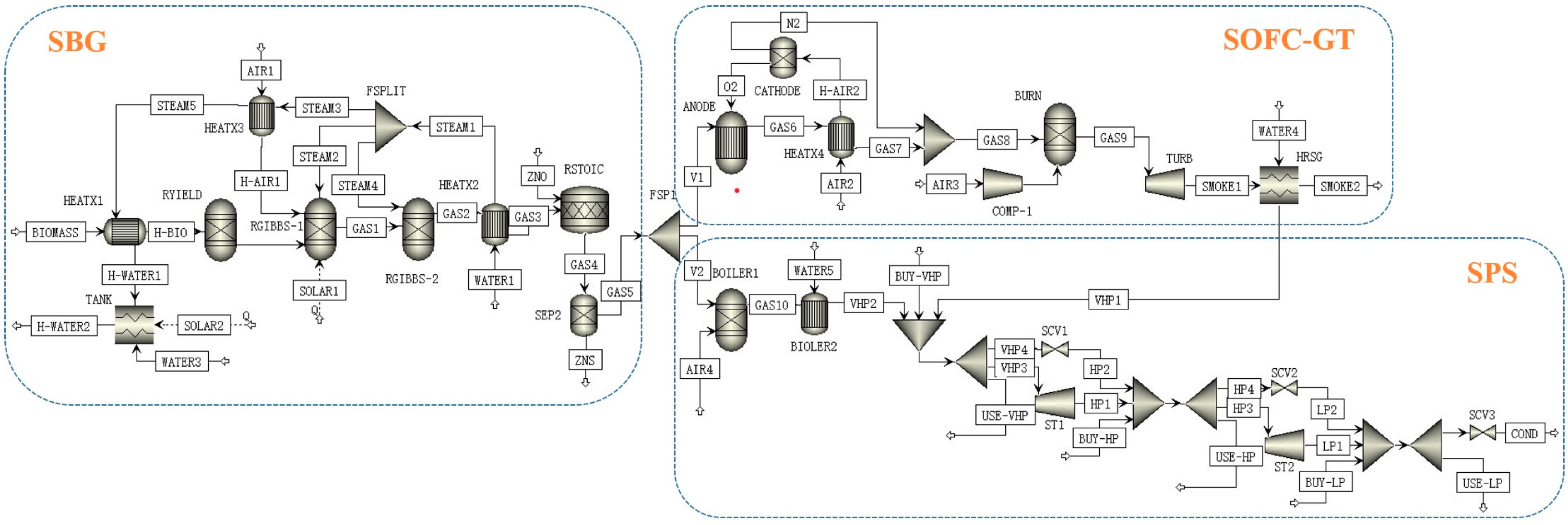
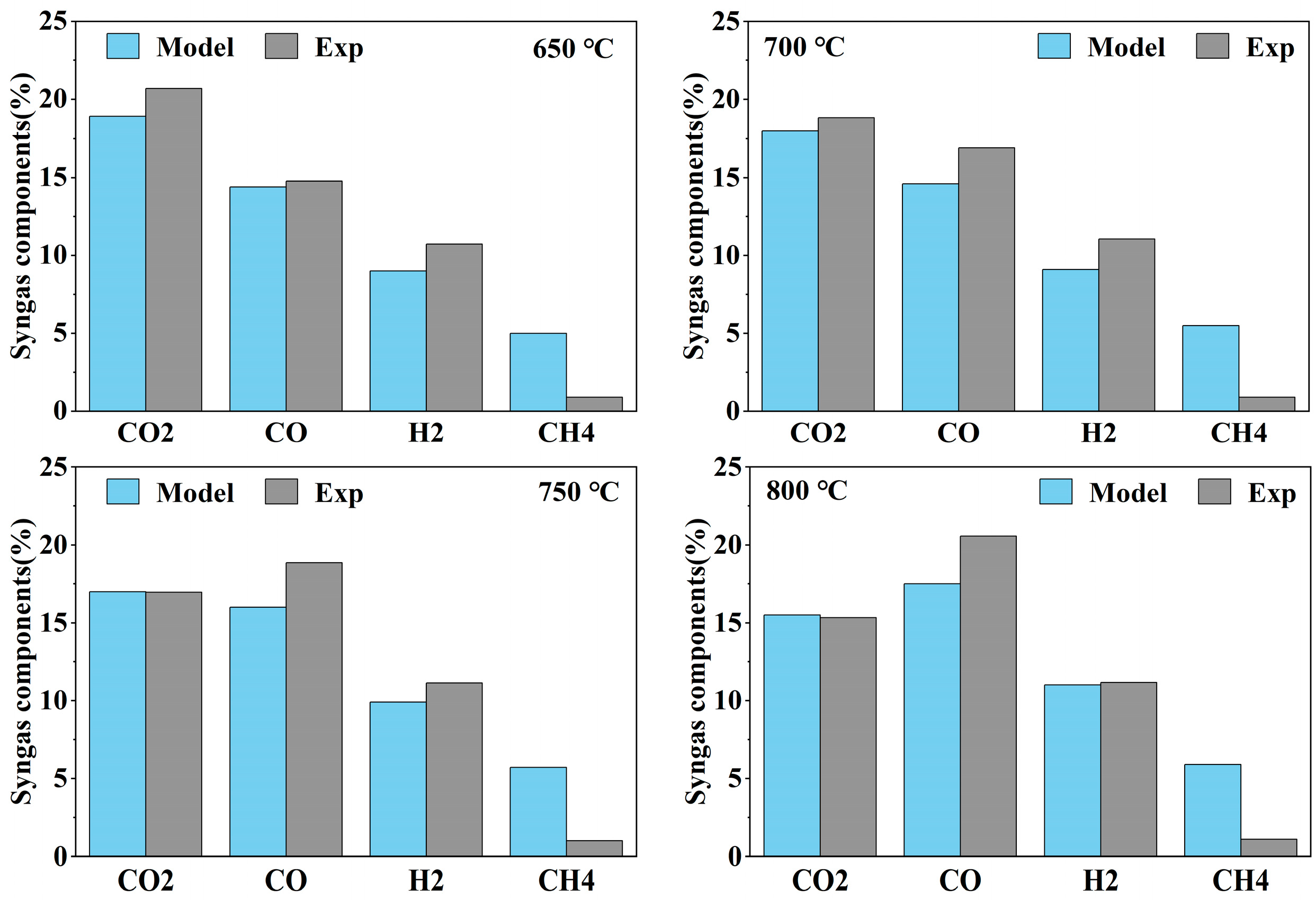
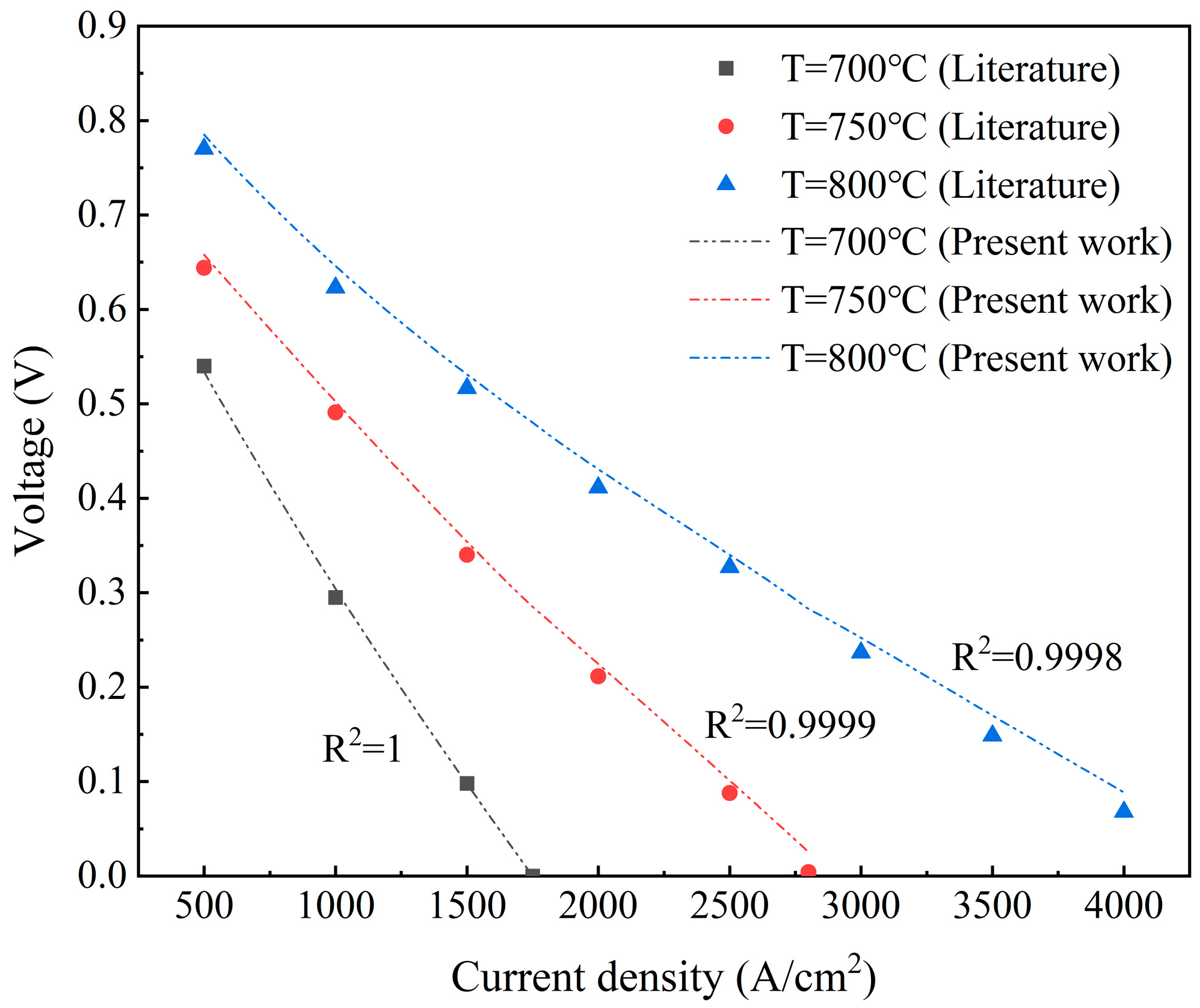
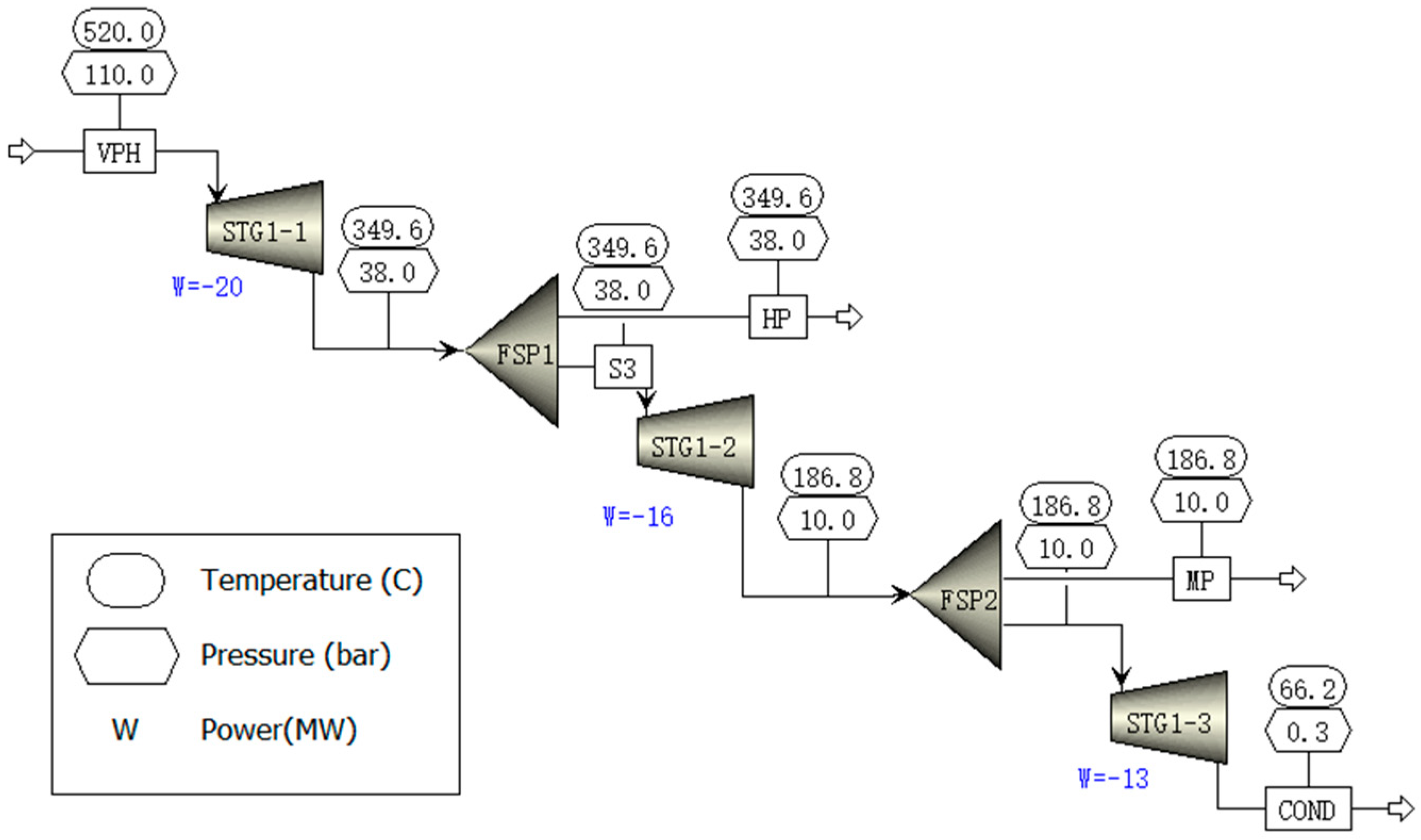

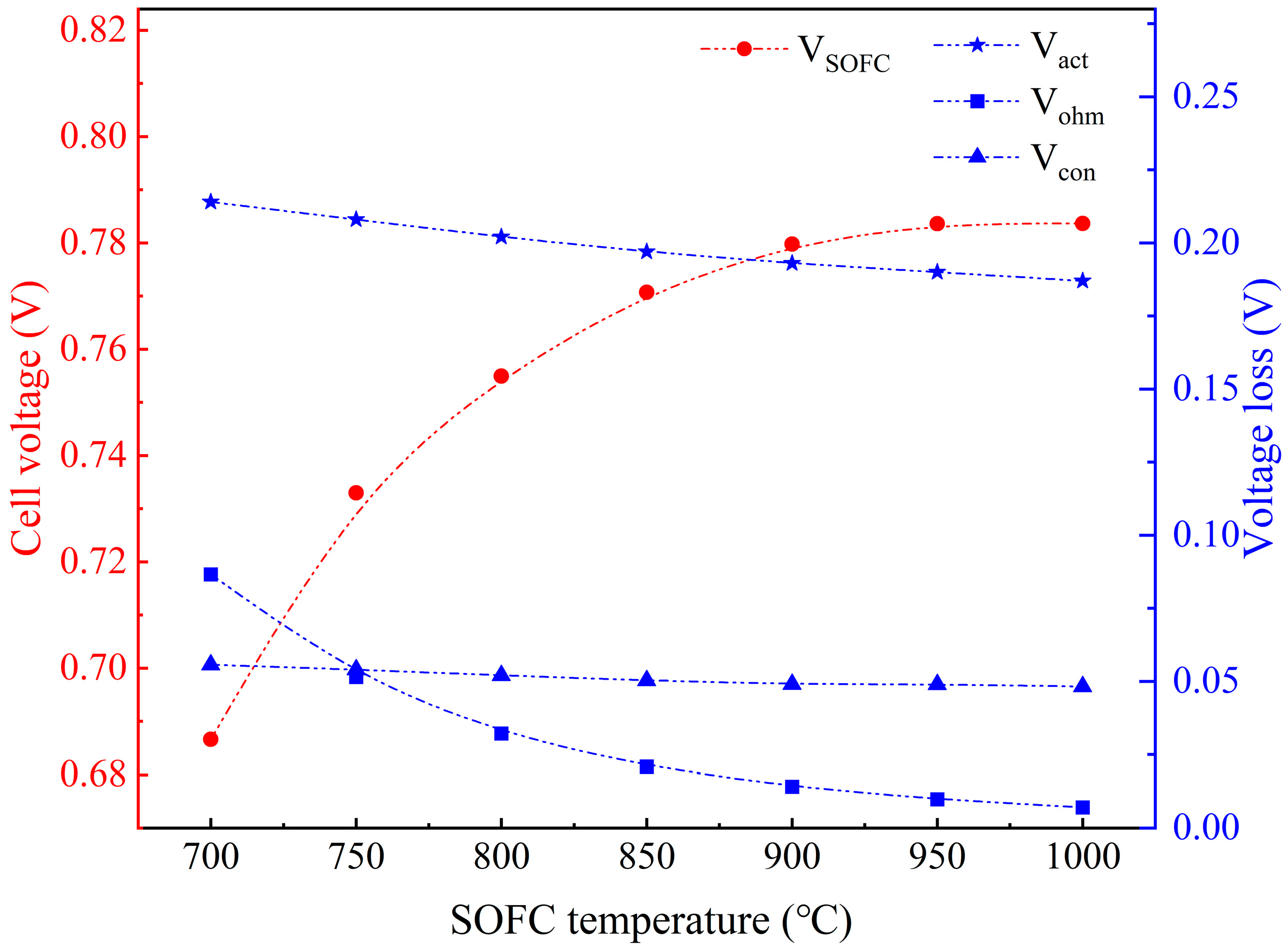
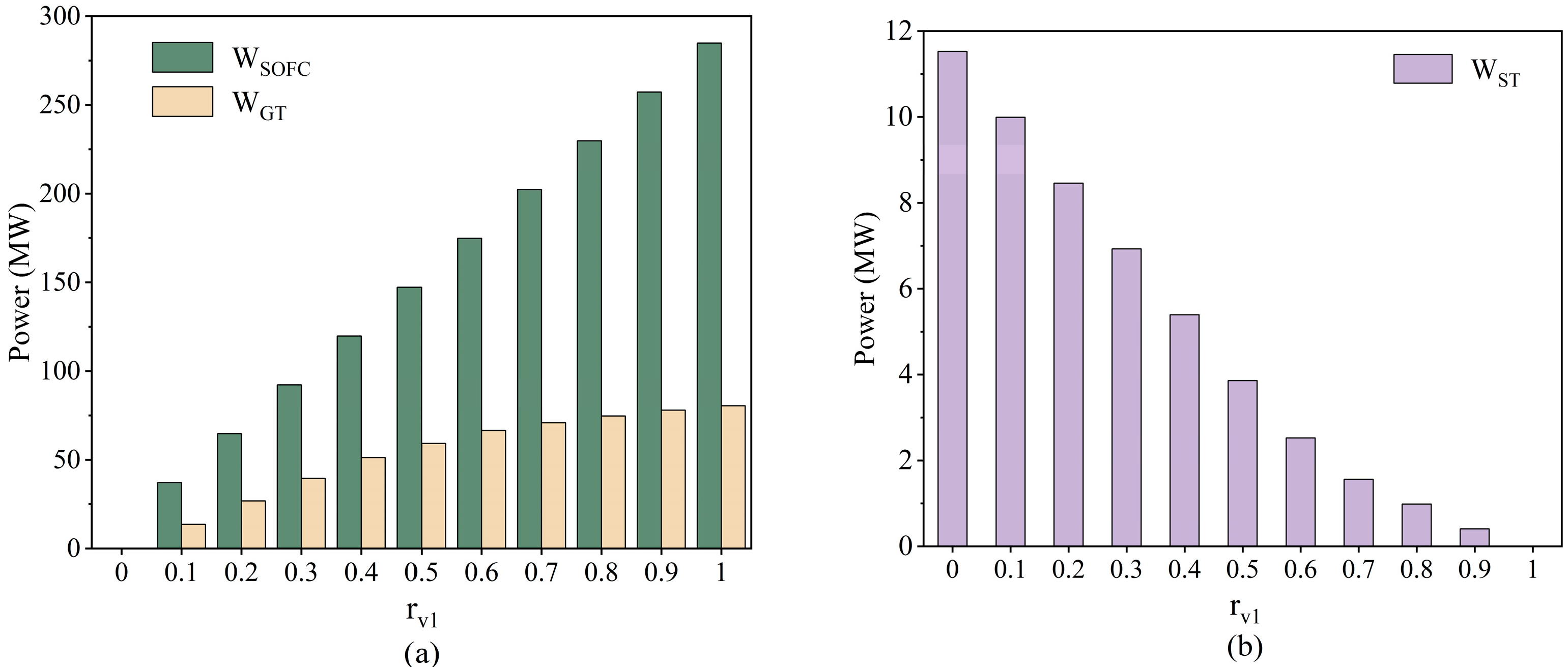
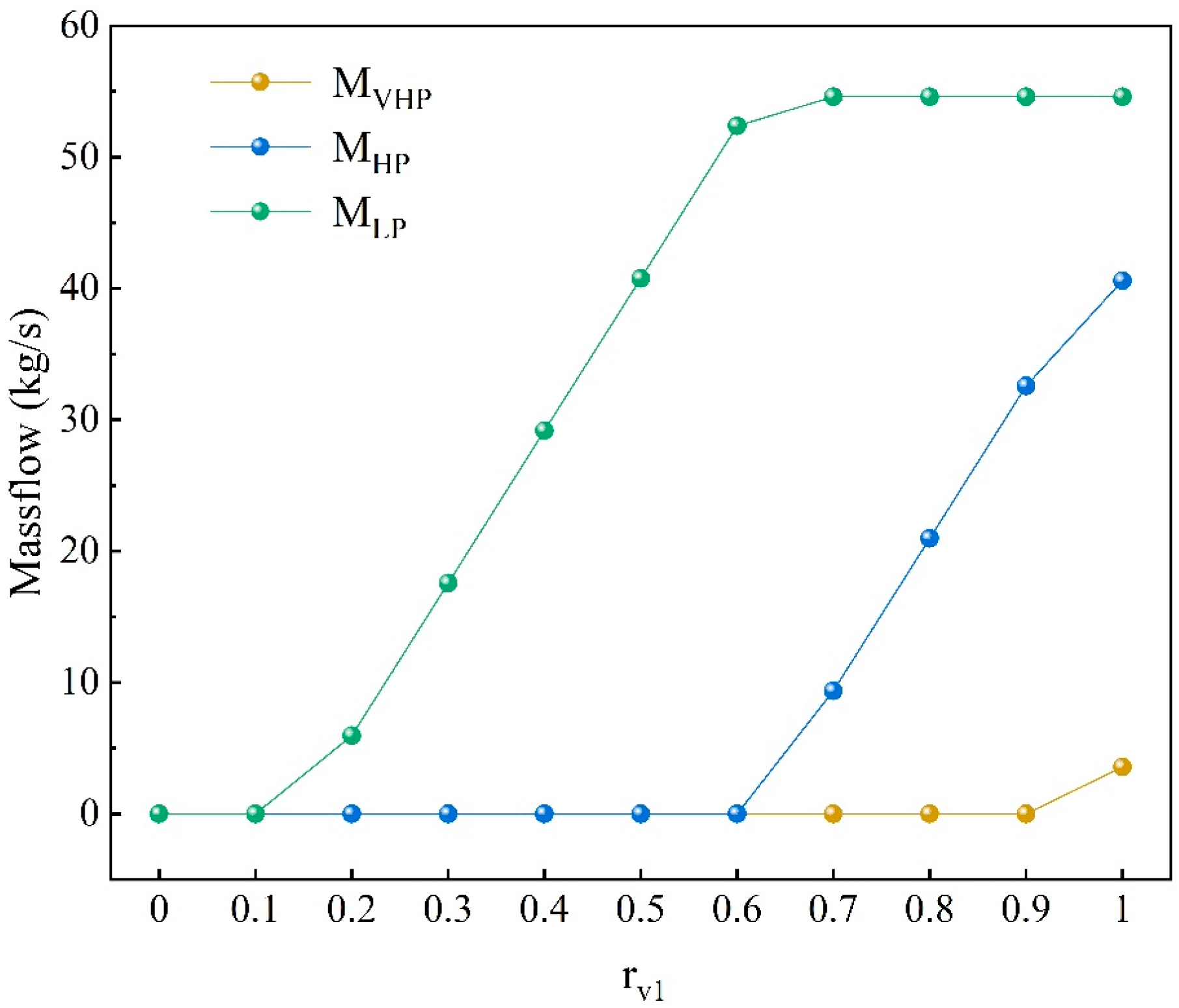
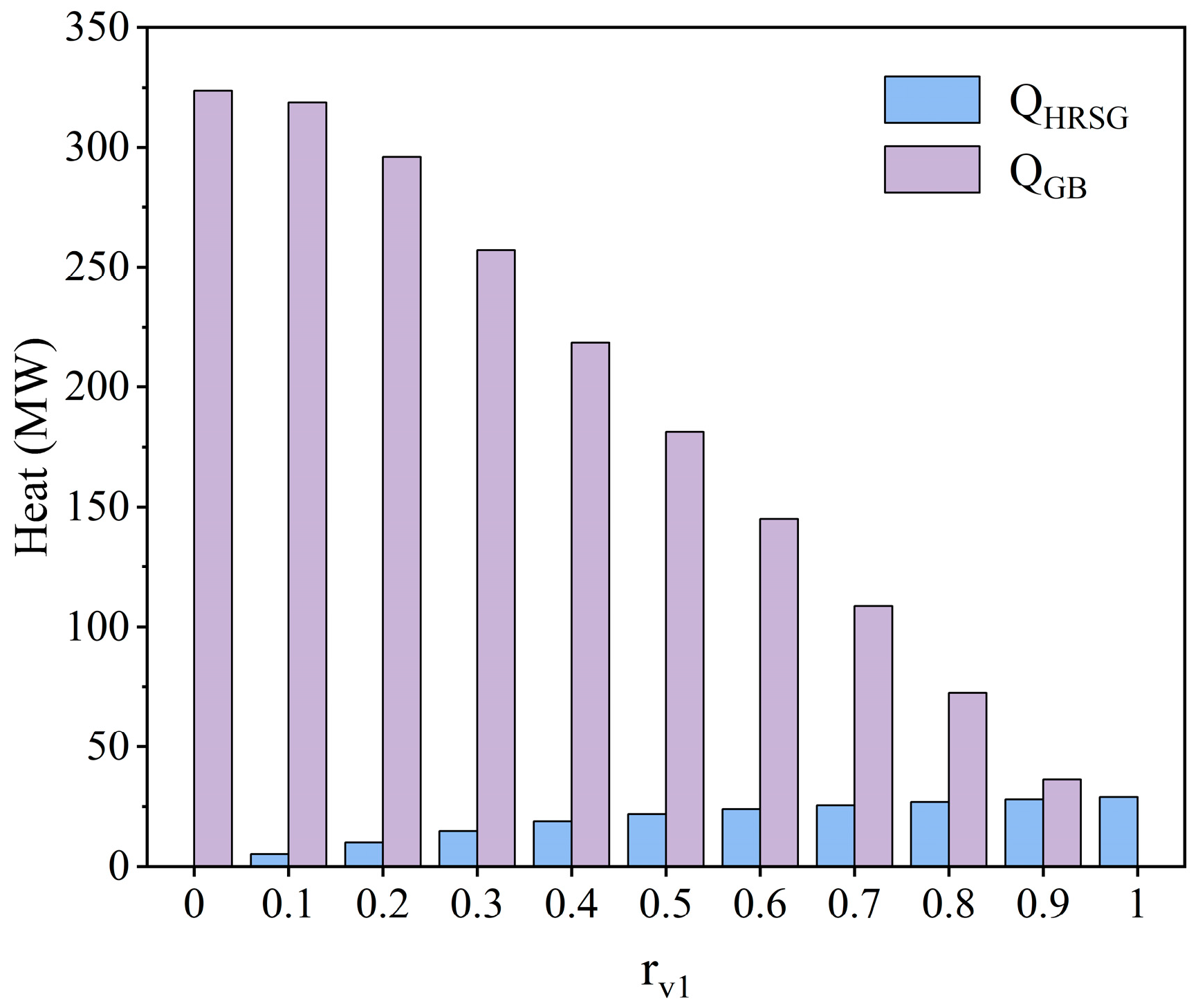
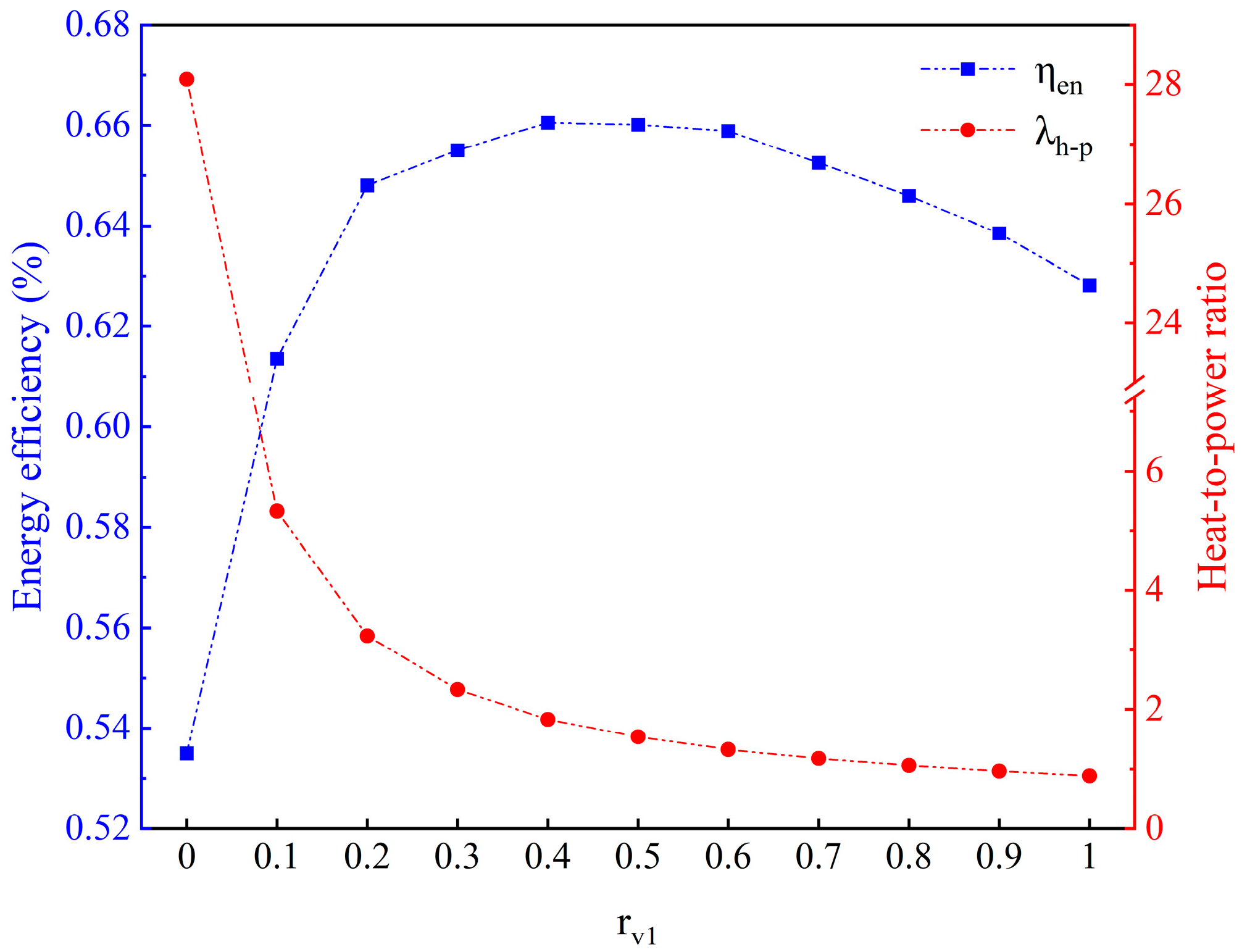
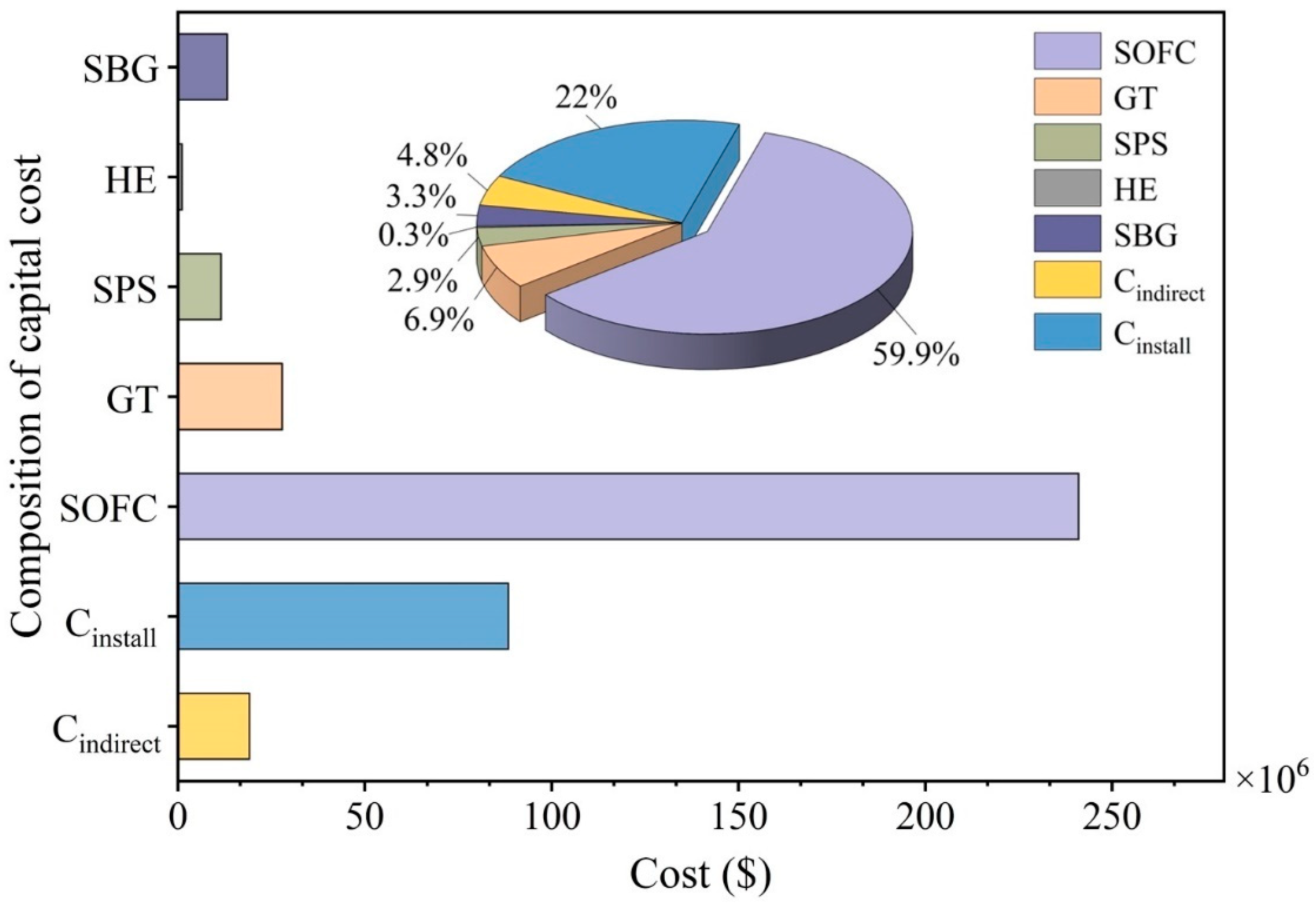
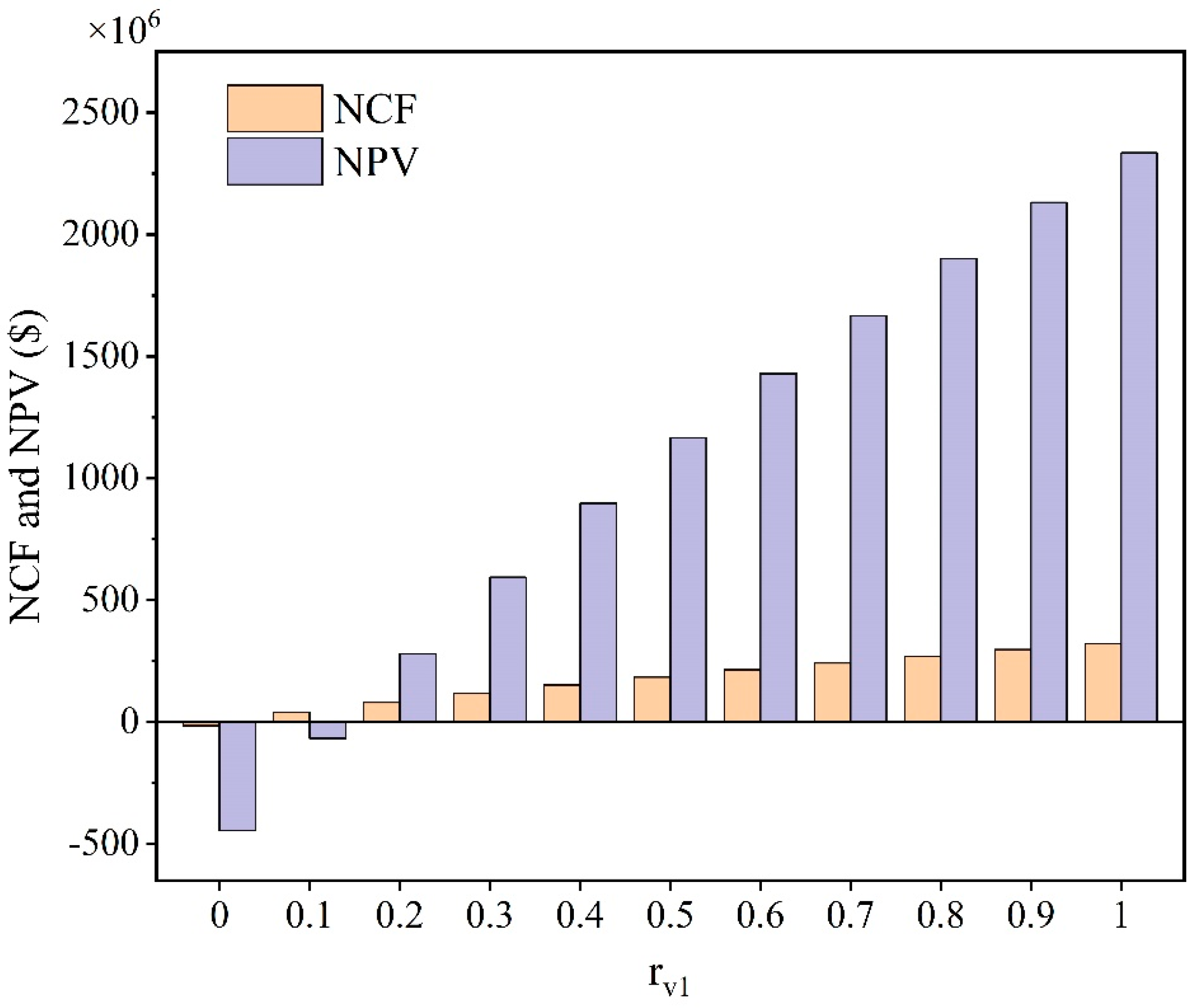
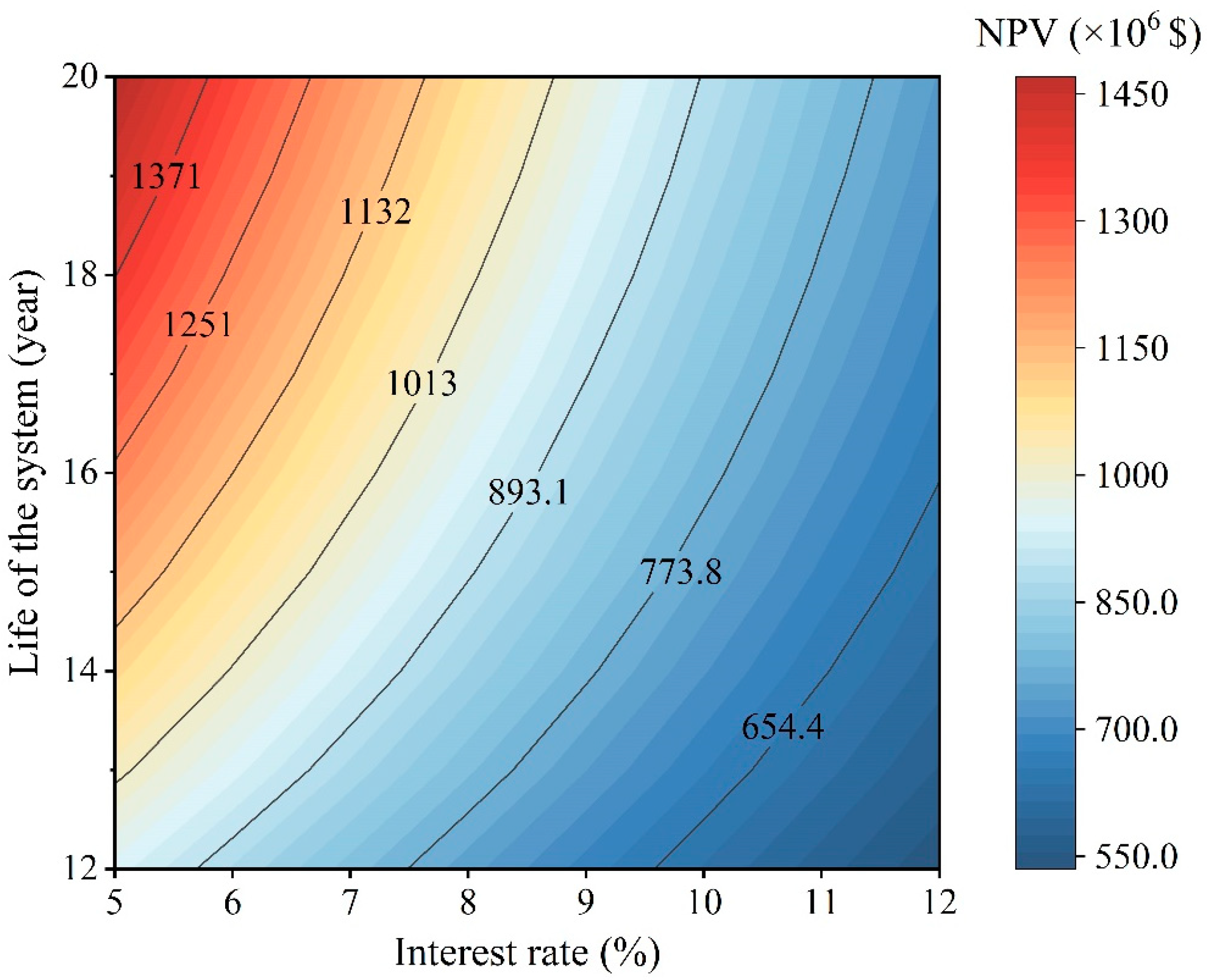

| rV1 | rV2 | |
|---|---|---|
| Config−1 | 0 | 1 |
| Config−2 | 1 | 0 |
| Config−3 | 0~1 | 1−rV1 |
| Component | Parameter | Value |
|---|---|---|
| SBG [8] | Biomass flow rate | 25 kg/s |
| Gasification temperature and pressure | 1000 °C, 1 bar | |
| Air-gasifying agent temperature | 200 °C | |
| Steam-gasifying agent temperature | 500 °C | |
| Domestic hot water | 80 °C | |
| SOFC [35,36,37,38] | SOFC operating temperature, TSOFC | 700–1000 °C |
| SOFC operating pressure, PSOFC | 1 bar | |
| Active surface area of cell, A | 0.01 m2 | |
| Exchange current density at the anode, | 6500 A/m2 | |
| Exchange current density at the cathode, | 2500 A/m2 | |
| Effective diffusivity coefficient on the anode side, | 0.2 cm2/s | |
| Effective diffusivity coefficient on the cathode side, | 0.05 cm2/s | |
| Anode resistivity, | 2.98 × 10−5 exp(−1392/Tavg) Ωm | |
| Cathode resistivity, | 8.114 × 10−5 exp(600/Tavg) m | |
| Electrolyte resistivity, | 2.94 × 10−5 exp(10,350/Tavg) m | |
| Thickness of anode, | 0.5 mm | |
| Thickness of cathode, | 0.01 mm | |
| Thickness of electrolyte, | 0.05 mm | |
| Thickness of interconnection | 3 mm | |
| Efficiency of DC to AC, | 97% | |
| Fuel utilization factor, | 85% | |
| Air utilization factor, | 16.7% | |
| GT [39] | Air compressor pressure | 17 bar |
| Combustion chamber temperature and pressure | 1400 °C | |
| Gas turbine discharge pressure | 1 bar | |
| SPS [40] | VHP steam | 101 bar, 550 °C |
| HP steam | 20.6 bar, 295 °C | |
| LP steam | 4.5 bar, 150 °C |
| Component | Out of Gasifier RGIBBS−1 (Stream GAS1) | Out of the Sorbent Reactor RGIBBS−2 (Stream GAS2) | Out of the Sulphur Removal (Stream GAS5) |
|---|---|---|---|
| H2 (%) | 10.8 | 10.9 | 10.9 |
| CO (%) | 28.0 | 28.2 | 28.2 |
| CO2 (%) | 11.9 | 12.1 | 12.1 |
| CH4 (%) | 1.1 | 1.1 | 1.1 |
| H2O (%) | 23.2 | 23.7 | 23.7 |
| CnHm (%) | 0.16 | 0.0004 | 0.0004 |
| NH3 (ppm) | 429.8 | 21.6 | 20.5 |
| H2S (ppm) | 571.8 | 86.2 | 0.3 |
| Item | Parameter |
|---|---|
| ) [15] | |
| Erection, steel structures, and painting (USD) | |
| Piping (USD) | |
| ) [15] | |
| Engineering/consulting costs (USD) | ) |
| Miscellaneous (USD) | ) |
| ) [15] | |
| Biomass fuel cost [54] | 40.09 USD/t |
| Purchased steam cost [55] | VHP: 40.41 USD/t; HP: 19.13 USD/t; LP: 18.43 USD/t |
| ) [15] | |
| Property, taxes, and insurance (USD) | |
| Labor cost (USD) | |
| Operation and maintenance cost (USD) | |
| Income | |
| , ) [56] | 0.128 USD/kWh |
| ) [55] | VHP: 40.41 USD/t; HP: 19.13 USD/t; LP: 18.43 USD/t |
| ) [57] | 0.036 USD/kWh |
| Other | |
| ) [46] | 10 USD/t |
| Interest rate (i) [58] | 8% |
| Life of the system (n) | 15 years |
| Literature [61] | Model Results | Error | |
|---|---|---|---|
| Input | |||
| Anode inlet gas component (%) | H2 27, CO 5.6, CH4 10.1, H2O 27.9, CO2 23.1, N2 6.2 | H2 27, CO 5.6, CH4 10.1, H2O 27.9, CO2 23.1, N2 6.2 | — |
| Anode inlet temperature (K) | 809.15 | 809.15 | — |
| Cathode inlet temperature (K) | 1094.47 | 1094.47 | — |
| Output | |||
| Anode exhaust gas component (%) | H2 11.6, CO 7.4, H2O 50.9, CO2 24.9, N2 5.1 | H2 11.1, CO 8.1, H2O 51.4, CO2 24.3, N2 5.1 | 3.4% |
| Stack exhaust temperature (K) | 1107 | 1158.54 | 4.7% |
| Voltage (mV) | 700 | 748 | 6.8% |
| Pressure of Header | Temperature of Header (°C) | ||
|---|---|---|---|
| Literature [63] | Present Model | Error | |
| VHP | 520 | 520 | 0 |
| HP | 349 | 349.6 | 0.17% |
| MP | 184 | 186.8 | 1.52% |
| Demand | Pressure (bar) | Amount (kg/s) |
|---|---|---|
| VHP | 101 | 3.6 |
| HP | 20.6 | 40.6 |
| LP | 4.5 | 54.6 |
| Parameter | Value |
|---|---|
| Biomass flow rate (kg/s) | 25 |
| Solar heat collecting system (MW) | 188.4 |
| SOFC capacity (MW) | 284.8 |
| GT capacity (MW) | 80.4 |
| GB capacity (MW) | 295.4 |
| HRSG capacity (MW) | 28.95 |
| ST1 capacity (MW) | 5.6 |
| ST2 capacity (MW) | 6.0 |
Disclaimer/Publisher’s Note: The statements, opinions and data contained in all publications are solely those of the individual author(s) and contributor(s) and not of MDPI and/or the editor(s). MDPI and/or the editor(s) disclaim responsibility for any injury to people or property resulting from any ideas, methods, instructions or products referred to in the content. |
© 2024 by the authors. Licensee MDPI, Basel, Switzerland. This article is an open access article distributed under the terms and conditions of the Creative Commons Attribution (CC BY) license (https://creativecommons.org/licenses/by/4.0/).
Share and Cite
Zhu, X.; Li, Z.; Tian, Y.; Huang, X. Configuration Strategy and Performance Analysis of Combined Heat and Power System Integrated with Biomass Gasification, Solid Oxide Fuel Cell, and Steam Power System. Processes 2024, 12, 446. https://doi.org/10.3390/pr12030446
Zhu X, Li Z, Tian Y, Huang X. Configuration Strategy and Performance Analysis of Combined Heat and Power System Integrated with Biomass Gasification, Solid Oxide Fuel Cell, and Steam Power System. Processes. 2024; 12(3):446. https://doi.org/10.3390/pr12030446
Chicago/Turabian StyleZhu, Xinyao, Zeqiu Li, Ying Tian, and Xiuhui Huang. 2024. "Configuration Strategy and Performance Analysis of Combined Heat and Power System Integrated with Biomass Gasification, Solid Oxide Fuel Cell, and Steam Power System" Processes 12, no. 3: 446. https://doi.org/10.3390/pr12030446






